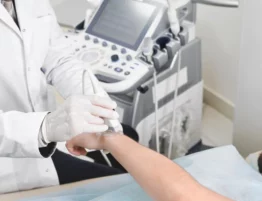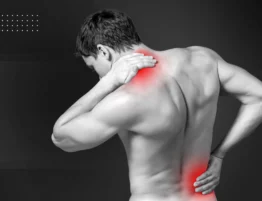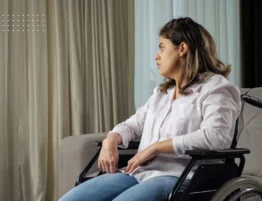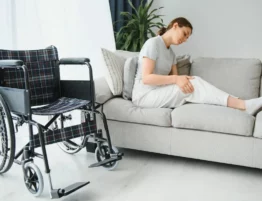Inflammatory myopathy is a group of rare immunological illnesses. Among their characteristics is a chronic inflammation of the muscles. It leads to their weakness and other associated manifestations. This condition affects the skeletal muscles, which are responsible for body movement. It can impact a person’s quality of life. There are two most common types of IM. Among them are dermatomyositis and polymyositis. Each has its unique features and clinical presentations. The exact cause of IM remains unclear. Such an illness can lead to muscle pain, weakness, and fatigue, as well as skin rashes in the case of dermatomyositis.
Inflammatory myopathy diagnosis involves a combination of medical history and physical examination. Also, muscle biopsies and gore tests. There is no cure for such an illness. Immunosuppressive medications, physical therapy, and lifestyle modifications aim to manage signs. Also, to improve a patient’s well-being. Ongoing research continues to explore the underlying mechanisms of this condition. It offers hope for more effective inflammatory myopathy therapy in the future.
What is Inflammatory Myopathy?
It is important to know what inflammatory myopathy is. This is a group of rare autoimmune diseases that affect the muscles. IM leads to chronic inflammation, muscle weakness, and various associated symptoms. These conditions fall under the category of autoimmune myopathies. Such illness occurs when the body’s protection system targets. It attacks its muscle tissues, leading to muscle inflammation and damage. This immune-mediated process can result in muscle pain and weakness. Also, fatigue makes it difficult for affected individuals to perform everyday tasks. The exact cause of inflammatory myopathy remains unknown. Genetic and environmental factors play a big role.
Inflammatory myopathy diagnosis involves a combination of medical history and physical examination. Also, gore tests and muscle biopsies. There is currently no treatment for this disease. Cure options often involve immunosuppressive medications to control the immune response, along. Physical therapy and lifestyle adjustments to manage signs and enhance life quality. Ongoing research seeks to understand the underlying mechanisms of these conditions better.
Inflammatory Myopathy Types
Such illness encompasses a spectrum of rare autoimmune disorders. They affect skeletal muscles, causing chronic inflammation and muscle weakness. There are several distinct types of inflammatory myopathies. Each with its clinical characteristics and specific features. Two of the most well-recognized types are dermatomyositis and polymyositis. Dermatomyositis is by both muscle inflammation and skin involvement. This leads to a distinctive rash on the skin. Such a condition often presents with muscle weakness and various skin changes. This makes it unique among IM.
Polymyositis involves inflammation of muscle without the accompanying skin manifestations seen in dermatomyositis. Patients with polymyositis experience muscle weakness, pain, and fatigue. There are the less common types. Among them are body myositis, necrotizing autoimmune myopathy, and antisynthetase syndrome. Each has its own distinct clinical and histological features. These conditions share the hallmark of immune-mediated muscle inflammation. Their specific clinical presentations and underlying mechanisms may vary. Necessitating tailored approaches to diagnosis and treatment for each subtype of inflammatory myopathy.
Dermatomyositis
This is a rare autoimmune IM characterized by muscle irritation. Also, distinctive skin manifestations. This condition affects the skeletal muscles, leading to muscle weakness, pain, and fatigue. What sets dermatomyositis apart from other IM is the presence of skin changes. They include a reddish or purple rash, most on the face, neck, and chest. Other skin manifestations may involve swelling, skin thickening, or cutaneous ulcerations. The exact cause of dermatomyositis remains unclear. It involves abnormal immune responses. Inflammatory myopathy treatment includes immunosuppressive medications to manage irritation. Also, physical therapy, and sun protection for the skin due to increased sensitivity.
Polymyositis
This is a rare autoimmune IM characterized by muscle inflammation and weakness. Unlike dermatomyositis, polymyositis doesn’t exhibit prominent skin involvement. This condition affects the skeletal muscles, leading to muscle pain, fatigue, and weakness. It can result in difficulties with mobility and everyday activities. The exact cause of polymyositis is still not fully understood, but it involves an abnormal immune response. Inflammation myopathy treatment often includes immunosuppressive medications. They control irritation and may include physical therapy. This way, it is possible to improve muscle strength and function. Early diagnosis and prompt intervention are essential for managing clinical manifestations. Also, for improving the patient’s quality of life.
Inclusion body myositis
IBM is a rare and progressive inflammatory myopathy that primarily affects older adults. Typically over the age of 50. Unlike other forms, IBM is distinct in its clinical presentation and response to treatment. This condition is weakness, particularly in the muscles of the fingers and wrists and quadriceps. IBM gets its name from the characteristic “inclusions” or abnormal protein deposits found. Within muscle cells, which contribute to muscle damage. IBM tends to be less responsive to classic immunosuppressive therapies. making it particularly challenging to manage. There is no known cure for IBM, and treatment focuses on signs management and physical therapy to maintain mobility and function. The exact cause of IBM remains unclear. It results from a combination of genetic and environmental factors. Ongoing research aims to uncover the underlying mechanisms of IBM. Also, to develop more effective inflammatory myopathy treatments.
Antisynthetase syndrome
It is a rare autoimmune disorder characterized by the presence of specific autoantibodies. These antibodies target enzymes involved in protein synthesis. Polymyositis and dermatomyositis are closely associated with inflammatory myopathy. Antisynthetase syndrome is a muscle inflammation and weakness, joint pain. Also, interstitial lung disease and skin rashes. Lung involvement is a prominent feature, leading to breathing difficulties and fibrosis. Early diagnosis is crucial, and treatment typically involves immunosuppressive medications. The aim is to manage inflammation, along with therapies to address specific symptoms. Close monitoring and multidisciplinary care are essential. They help to improve the patient’s quality of life and manage this complex condition.
Juvenile dermatomyositis
JDM is a rare autoimmune inflammatory myopathy that primarily affects children and adolescents. It includes muscle irritation, muscle weakness, and distinctive skin changes. Such as a violet-colored rash on the eyelids and knuckles. JDM can lead to muscle pain, fatigue, and mobility challenges. They impact a child’s daily life and activities. The exact cause of JDM is not fully understood. It involves abnormal immune responses. Timely diagnosis is critical to start appropriate treatment. It includes immunosuppressive medications and physical therapy. This way is possible to manage inflammation and improve muscle strength. Early intervention and ongoing care are necessary. This way, many children with JDM can achieve improved long-term outcomes and quality of life.
Inflammatory Myopathies Symptoms
Inflammatory myopathies symptoms encompass a group of rare autoimmune muscle disorders. With a common hallmark of chronic muscle inflammation. The signs can vary depending on the specific type of IM but generally include:
- Muscle Weakness: This is a primary symptom affecting various muscle groups. It often makes it difficult to perform daily tasks.
- Muscle Pain: Individuals may experience muscle pain or discomfort. It can be widespread or localized to specific muscle groups.
- Fatigue: Muscle inflammation and weakness can lead to significant fatigue. They reduce energy levels.
- Skin Changes: In the case of dermatomyositis, a distinct skin rash on the face, neck, and chest may be present.
- Difficulty Swallowing: Some forms of IM can affect the muscles involved in swallowing. This way is causing dysphagia.
- Joint Pain: It can occur in some types, particularly in overlap syndromes.
- Breathing Difficulties: Lung involvement may lead to shortness of breath and cough. Also, an interstitial lung disease in certain cases.
- Muscle Atrophy: Over time, untreated IM may lead to muscle atrophy or loss of muscle mass.
Early diagnosis and appropriate management are essential to ease manifestations. Slow disease progression and enhance the patient’s quality of life.
Inflammatory Myopathies Diagnosis
This is a complex process. It includes a combination of clinical evaluation, laboratory tests, and sometimes invasive procedures. Key steps in the inflammatory myopathy diagnosis include:
- Medical History and Physical Examination: The doctor will discuss these moments. He conducts a thorough physical examination to assess muscle strength. Also, mobility and any associated skin or systemic symptoms.
- Blood Tests: They detect specific markers. Such as elevated creatine kinase levels and the presence of autoantibodies.
- Muscle Biopsy: It is often essential to confirm the presence of muscle inflammation. Also, assess the extent of muscle damage. This procedure involves removing a small piece of muscle tissue for examination under a microscope.
- Electromyography: EMG measures electrical activity in the muscles. It helps identify patterns consistent with muscle inflammation or damage.
- Imaging Studies: X-rays, MRI, or CT scans help to assess muscle and lung involvement.
- Pulmonary Function Tests: If lung involvement, pulmonary function tests can test lung capacity.
- Other Tests: Skin or joint biopsies or autoimmune serology are necessary in specific cases. Particularly for overlap syndromes.
Accurate diagnosis is crucial to tailor treatment strategies. Different inflammatory myopathies types may need distinct therapeutic approaches. You can find more information about it on our site.
Inflammatory Myopathies Treatment
Healing methods aim to manage muscle inflammation. Also, eases signs and improves the patient’s quality of life. Therapy approaches may vary depending on the specific type of illness and individual patient needs. Common inflammatory myopathy treatments include:
- Immunosuppressive Medications: Corticosteroids like prednisone are often the first-line treatment. They help to suppress the immune system’s inflammatory response. Methotrexate, azathioprine, or mycophenolate mofetil are necessary to reduce corticosteroid doses.
- Physical Therapy: It plays a critical role in maintaining muscle strength and function. Also, improving mobility and managing joint stiffness.
- Medicines for Sign Management: Pain relievers, NSAIDs, and drugs to address specific signs.
- Biologic Therapies: In refractory cases, biologic agents like rituximab or IVIG are necessary.
- Sun Protection: Patients with dermatomyositis should protect their skin from sun exposure. This way, they cut skin rash exacerbation.
- Lung Care: In cases of lung involvement, respiratory therapy and medications may be necessary. They help to manage lung manifestations and prevent complications.
- Supportive Care: Mobility aids nutritional and psychological support can enhance the patient’s well-being.
The treatment plan is individual, and close medical monitoring is crucial to manage disease activity and side effects. Early intervention and multidisciplinary care may improve outcomes for individuals with inflammatory myopathies.
Conclusion
IM represents a group of rare autoimmune muscle disorders that can affect an individual’s life. It is possible to characterize it by dermatomyositis, polymyositis, and inclusion body myositis. They lead to muscle weakness, pain, and a range of associated manifestations. Early and accurate diagnosis is essential. Timely intervention can impact disease progression and the patient’s quality of life. While there is no cure for IM, treatment options aim to manage inflammation of muscles. Also, it reduces manifestations and improves muscle function.
Immunosuppressive medicines, physical and sign-specific therapies are often a part of the treatment plan. Research into these conditions continues. It offers hope for more effective treatments in the future. Living with an IM can be challenging. Proper medical care, supportive therapies, and a multidisciplinary approach are necessary. Individuals affected by these disorders can achieve better control over their signs. Also, they may maintain a higher quality of life. You should contact a doctor immediately after you recognize IM manifestations.
FAQ
What triggers inflammatory myopathy?
They are not fully understood. Genetic predisposition and environmental factors start the autoimmune response against muscle tissue.
How common is inflammatory myopathy?
Such illnesses are rare, with an estimated prevalence of approximately 10 to 20 cases per 100,000 people. This makes them relatively uncommon conditions.
Are there any lifestyle changes that can help manage symptoms?
Yes, certain lifestyle changes can help manage signs of inflammatory myopathies. Regular low-impact exercise, a balanced diet, and sun protection for dermatomyositis patients. Also, stress reduction techniques to improve well-being.
Can inflammatory myopathy be cured?
No, there is no cure, but it can often be effectively managed through a combination of medical treatments. Also, lifestyle adjustments to control symptoms and improve the patient’s quality of life.











Please, leave your review
Write a comment: